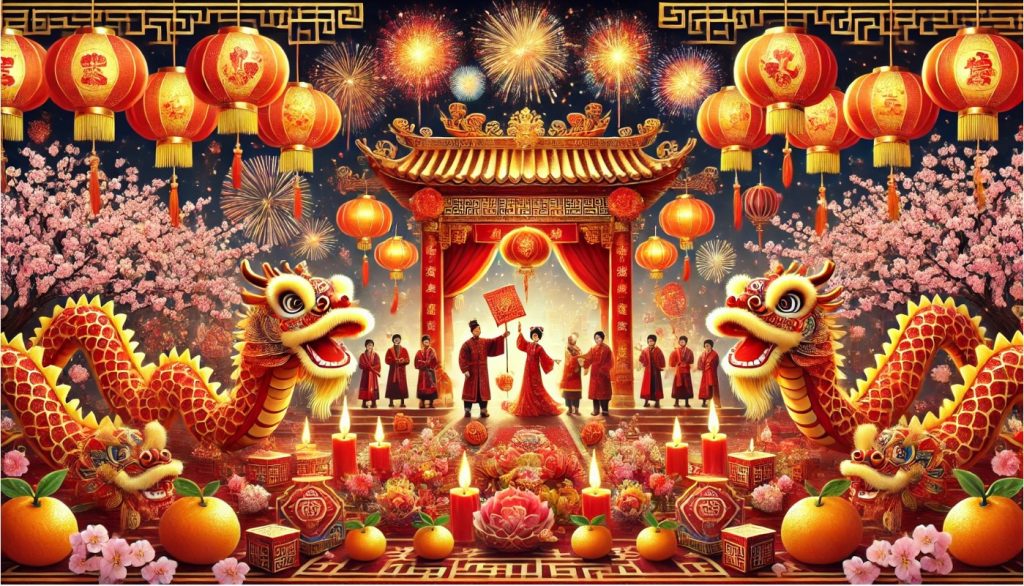Chinese New Year, also known as the Spring Festival (春节, Chūnjié), is the most significant and widely celebrated festival in China and many other parts of Asia. It marks the beginning of the lunar new year and is a time for families to reunite, pay respects to ancestors, and celebrate new beginnings. With deep cultural and historical roots, Chinese New Year encompasses a rich array of customs, traditions, and events that span over a period of 15 days, culminating with the Lantern Festival.
The celebration of Chinese New Year is an amalgamation of ancient customs, beliefs, and family values, with various regions across China adding their own unique flavor to the festivities. Beyond the boundaries of China, the festival is also celebrated in countries with significant Chinese populations, such as Taiwan, Hong Kong, Singapore, Malaysia, and Chinatowns around the world.
History and Origins of Chinese New Year
Ancient Roots and Lunar Calendar
Chinese New Year has its origins in ancient agricultural practices, rooted in the lunar calendar and the cycles of the moon. The holiday marks the end of winter and the beginning of the spring planting season, symbolizing renewal and a fresh start. Historically, Chinese New Year was a time to honor deities, ancestors, and the forces of nature to ensure a good harvest in the coming year.
The celebration is based on the Chinese lunisolar calendar, which is a combination of the lunar and solar cycles. Unlike the Gregorian calendar, the Chinese New Year falls between January 21 and February 20, depending on the lunar cycle. The festival starts on the first day of the lunar new year and continues for 15 days, with different customs observed each day.
The Legend of Nian
One of the most well-known legends associated with Chinese New Year is the myth of Nian (年), a fearsome monster that would emerge from the mountains at the end of each year to terrorize villages. According to the legend, Nian would destroy crops, harm livestock, and even attack villagers. In response, the villagers devised a plan to scare away the beast. They discovered that Nian was afraid of loud noises, the color red, and fire. To protect themselves, villagers decorated their homes with red lanterns, set off firecrackers, and wore red clothing to ward off the monster.
This legend is the origin of many of the customs associated with Chinese New Year, such as the use of the color red, the setting off of fireworks, and the general emphasis on making noise to drive away evil spirits.
Transition to the Spring Festival
Over time, Chinese New Year evolved into a celebration of family reunification, good fortune, and the worship of ancestors. With the influence of Buddhism and other cultural traditions, the festival gradually transformed from a primarily agricultural ritual to a more social and spiritual event. Today, Chinese New Year is a time not only for honoring ancestors but also for strengthening family bonds, celebrating prosperity, and wishing for health and happiness in the coming year.
Customs and Traditions
Pre-Festival Preparations
In the days leading up to Chinese New Year, families prepare by cleaning their homes, a practice known as spring cleaning. This is believed to sweep away bad luck and make room for good fortune in the new year. However, cleaning should not be done on New Year’s Day itself, as it is thought to sweep away the good luck that arrives with the new year.
Decorations play a significant role in the lead-up to the festival. Homes are adorned with red couplets (对联, duìlián), banners with auspicious phrases written in gold or black, and paper cuttings of auspicious symbols such as the Fu character (福), which means “good fortune.” Red lanterns, flowers, and symbolic objects like plum blossoms or kumquat trees are also used to bring in good luck and happiness.
Giving Red Envelopes (Hongbao)
One of the most cherished customs during Chinese New Year is the giving of red envelopes (红包, hóngbāo), which contain money. These envelopes are typically given to children, younger family members, and unmarried friends. The amount of money inside is usually an even number, as odd numbers are associated with funerals. The color red symbolizes good luck, prosperity, and happiness, making the red envelope a symbol of good fortune.
Parents, grandparents, and other elders usually give red envelopes to younger family members, while married couples may also give hongbao to singles. In modern times, digital red envelopes have become popular, with many people sending electronic versions of hongbao via mobile payment apps like WeChat and Alipay.
Reunion Dinner (Nian Ye Fan)
The reunion dinner (年夜饭, nián yè fàn) is one of the most important traditions of Chinese New Year. It is a meal that families gather for on the evening of Chinese New Year’s Eve, symbolizing the unity of family and the hope for a prosperous year ahead. The reunion dinner is typically a lavish feast with multiple courses, and the menu includes foods that are symbolic of wealth, happiness, and longevity.
Key dishes often served during the reunion dinner include:
- Dumplings (饺子, jiǎozi): These crescent-shaped dumplings are said to resemble ancient Chinese gold ingots and are considered a symbol of wealth and prosperity. In some regions, families place a coin in one dumpling, and the person who finds it is believed to have good luck in the coming year.
- Fish (鱼, yú): The word for fish sounds like “surplus” in Chinese, symbolizing abundance and prosperity. A whole fish is usually served to represent a complete, unbroken cycle of fortune.
- Nian Gao (年糕): This sticky rice cake is a traditional food symbolizing progress and growth. The word “nian” means “year,” and “gao” sounds like “tall” or “higher,” symbolizing growth and a better year ahead.
The family reunion dinner is a time for families to reconnect, reflect on the past year, and celebrate new beginnings. It is also a time for the youngest members to honor their elders, usually by offering a toast or expressing good wishes for the upcoming year.
New Year’s Day Traditions
On New Year’s Day itself, several customs are followed to ensure good luck for the year ahead. These customs vary by region but generally include:
- First Visitor: The first person to visit a household on New Year’s Day is considered crucial to the fortune of the household for the rest of the year. Ideally, this person should be someone who brings good luck, and gifts or red envelopes are often exchanged.
- New Year Greetings: People visit friends, relatives, and neighbors to exchange well wishes. Common phrases include:
- “Gong Xi Fa Cai” (恭喜发财): Wishing you prosperity.
- “Xin Nian Kuai Le” (新年快乐): Happy New Year.
- “Wan Shi Ru Yi” (万事如意): May all your wishes come true.
- Avoiding Taboos: Certain activities are believed to bring bad luck on New Year’s Day, such as cleaning, washing hair (which is thought to wash away good fortune), and using sharp objects like scissors or knives.
Lantern Festival (Yuan Xiao Jie)
The Lantern Festival (元宵节, Yuánxiāo Jié) marks the conclusion of the Chinese New Year celebrations, occurring on the 15th day of the new year. Traditionally, the Lantern Festival is a celebration of light, symbolizing the dispelling of darkness and the arrival of spring. The festival is known for its spectacular displays of lanterns, which come in a variety of shapes and sizes, ranging from traditional red lanterns to elaborate designs depicting animals, mythical creatures, and famous characters.
One of the central activities during the Lantern Festival is the eating of tangyuan (汤圆), sweet rice dumplings filled with various fillings such as sesame paste, red bean paste, or peanut butter. The round shape of the dumplings symbolizes unity and completeness, and eating them is believed to bring families closer together.
The Lantern Festival is also associated with various forms of entertainment, including dragon and lion dances, fireworks, and the lighting of lanterns in public spaces.
Symbolism and Superstitions
Color Red and Other Auspicious Symbols
The color red is omnipresent during Chinese New Year celebrations, symbolizing good fortune, joy, and happiness. It is believed that the bright color helps to ward off evil spirits and bring in positive energy for the new year. Red envelopes, clothing, decorations, and even foods such as red-colored fruit (like oranges) are used extensively throughout the festival.
Other symbols of good fortune are also prominent during Chinese New Year, such as:
- Peach blossoms: Representing longevity and immortality.
- Kumquat: A symbol of wealth and good fortune.
- Gold ingots: Representing prosperity and the hope for financial success.
Avoiding Bad Luck
Chinese New Year is also a time to avoid actions that could bring bad luck. Among the common superstitions are:
- Not sweeping or cleaning on New Year’s Day: This is believed to sweep away wealth and good fortune.
- Avoiding the use of negative words: Words related to death, illness, or misfortune should be avoided, as they are believed to attract bad luck.
- Not breaking dishes or glassware: Breaking items during the New Year period is believed to symbolize the breaking of good fortune.
Regional Variations and Celebrations Worldwide
Regional Traditions
While Chinese New Year is celebrated throughout China, there are distinct regional variations in customs and cuisine. For example, in the South of China, especially in regions like Guangdong, steamed fish, prawns, and citrus fruits are commonly consumed, while in the North, dumplings are the focus of the reunion dinner. In Fujian and Zhejiang, it is customary to include lotus seeds and whole chicken for good luck.
Chinese New Year in Other Countries
Outside of China, Chinese New Year is also celebrated with fervor in many countries with significant Chinese populations. In Hong Kong, Taiwan, Singapore, and Malaysia, festivities are similar to those in mainland China, but each location has its own unique take on traditions, from parades to dragon dances.
Chinese New Year celebrations are also widely observed in Chinatowns across the world, with large cities such as New York, London, and San Francisco hosting vibrant parades, fireworks displays, and cultural performances. In these global celebrations, Chinese communities come together to preserve their cultural heritage while sharing the joy of the new year with people of all backgrounds.
Overall, Chinese New Year represents a time of renewal, family, and hope for prosperity, offering a rich and colorful celebration that brings together people across the world.







